Emergency dispatches offer new perspective on Eastway Tank explosion response
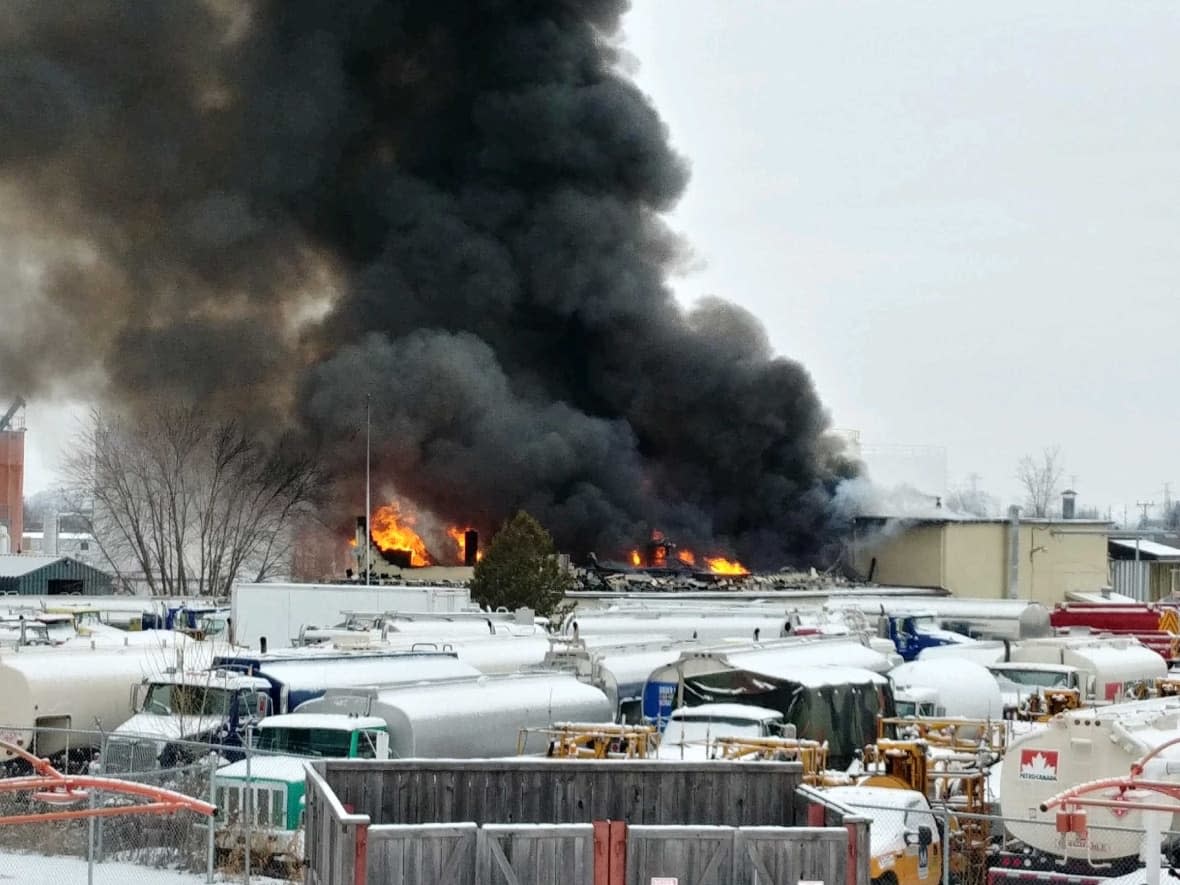
New documents obtained by CBC News provide a vivid timeline of the massive emergency response to the explosion and fire that killed six employees of Eastway Tank Pump & Meter Ltd. in Ottawa on Jan. 13.
The 44-page incident report, obtained through municipal freedom of information legislation, includes minute-by-minute dispatch notes detailing not only how firefighters toiled for hours in frigid conditions to control the volatile blaze, but also their commanders' concerns about the potential for secondary explosions, collapsing walls and a stream of uncontained fuel spilling from the industrial property toward nearby railway tracks.
The incident report also reveals the size and scope of the response to what would quickly become a rare five-alarm call.
It lists all 134 firefighters and their rigs — 20 pumpers, four ladder trucks, four tower trucks and numerous other pieces of heavy equipment — so many that commanders had to juggle resources to ensure the rest of the city was adequately covered in the event of another emergency.
Entries pertaining to the dead and injured have been severed from the documents in accordance with legislation guarding individual privacy.
Eastway employees Rick Bastien, Danny Beale, Kayla Ferguson, Matt Kearney, Etienne Mabiala and Russell McLellan died as a result of the disaster.

First calls to 911
According to the dispatch notes, the first calls to 911 began just before 1:30 p.m. (The notes provide brief summaries of the communications, not verbatim transcripts.)
"Lots of black smoke, flames shooting up 50-60 [feet]."
"Black smoke shooting from the roof."
"Eastway Trucking Company."
"Building might be collapsed per another 911 caller."
"Caller reporting fire spread all over the roof."
"All stations notified."
The first mention of victims, which has been redacted, comes seconds later. Several more reports, apparently from 911 callers at the scene, follow in quick succession.
At 1:36 p.m., Ottawa police are said to be setting up a perimeter around the burning building.

About one minute later the first fire crew, Pumper 25, arrives and approaches the burning building's north side from an adjacent Petro Canada yard. The nearest of several large fuel storage tanks on the Petro Canada property is only 50 metres away.
"Structure fully [involved] at this time," the dispatcher reports seconds later.
Enbridge and Hydro Ottawa are notified to shut off utilities, and Pumper 25 calls for paramedics to the Eastway entrance, presumably to treat victims.
'Multiple hazards'
By 1:41 p.m. Pumper 25 has a hose going, but the crew asks for help running a high-volume line to a hydrant on Merivale Road.
As more trucks arrive a second alarm is requested, summoning more crews to the scene.
At 1:43 p.m., Pumper 24 reports: "Roof is caving in — walls will collapse shortly."
Pumper 24, from a nearby station that serves as one of Ottawa's two hazmat bases, then issues a warning about the dangerous fuels and chemicals inside the burning building: "Lots of hydrocarbons in there."
In his internal remarks filed eight days later, incident safety officer Kip Muller noted "multiple hazards" at the scene including a potential wall collapse, a propane heater on the building's south side, a tanker truck that was left running beside the building and two more tankers "possibly having flammable liquids or hazardous materials on board" parked inside service bays at the building's east end.
Seconds after the warning about hydrocarbons, dispatch reports: "Strictly defensive fire. No crews inside."
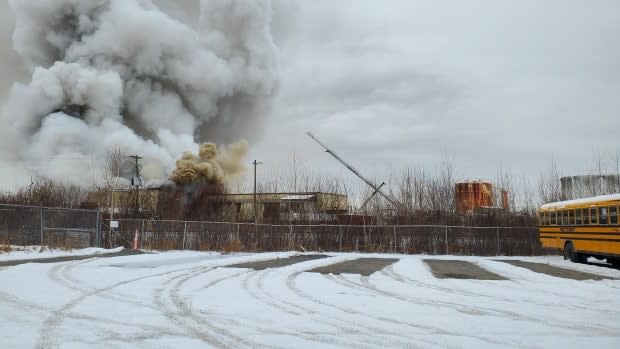
Crews battled to contain flames
At 1:46 p.m., Pumper 34 is designated as the rapid intervention team to rescue any firefighters who are injured or become trapped, while Pumper 37 is tasked with "accountability" — keeping track of which crews are doing what so no one goes missing.
Two minutes later, Pumper 23 confirms the two-storey shop where the initial explosion is believed to have occurred is fully involved, but the crew is "trying to stop it from getting to the 3rd section of the building," which contains the four service bays.
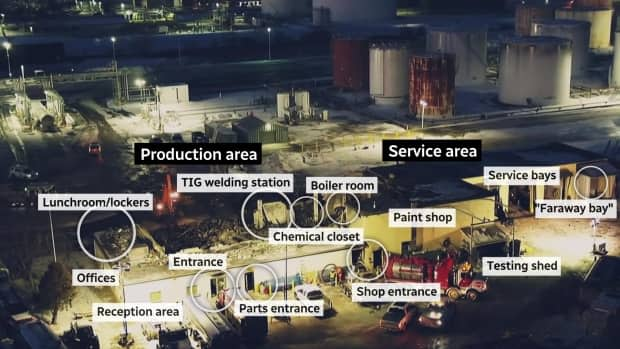
At 1:52 p.m. a third alarm is called, summoning two more pumpers, one more ladder truck and a district chief.
A minute later, dispatch reports crews are having trouble reaching the building's south side due to a hose blocking access.
At 1:55 p.m. a district chief on the scene reports to command that there are "2-3 oil tankers inside building." Two minutes later, it's reported that Insp. Jimmy Fata, a divisional chief, is on his way to the scene.
As ladder trucks arrive and begin setting up, a district chief orders crews to direct their streams through the billowing smoke toward the centre of the burning building. These instructions continue throughout the afternoon and into the evening.
Water pressure was also a concern as crews fought to maintain the flow needed to douse the flames. At 2:07 p.m., dispatch advises the city has been contacted to find out "who will be responding from the water division."
At the same time, a "unified command" post including Ottawa Fire Services, Ottawa police and paramedics is established in the parking lot of a commercial building across Merivale Road.
Wall collapse feared
By 2:12 p.m., fearing an imminent wall collapse, the safety officer on the scene orders an exclusion zone be established on the south side of the building to avoid potential injury to firefighters.
At 2:14 p.m., dispatch notifies crews that a fire-suppressing foam truck from the Ottawa International Airport is available if needed. (Foam can be used to suppress "Class B" fires, which involve flammable liquids. The Ottawa Fire Services' own foam unit arrived on the scene at 2:08, according to the incident report.)
Seconds after a fourth alarm is called at 2:41 p.m., loud booms are heard coming from inside the burning building.
"Couple tires blew off rig inside," dispatch reports.

At 2:48 p.m., a rare fifth alarm is called. Three minutes later, a cinderblock wall on the building's south side collapses onto the first-storey roof. A few minutes later, a district chief suggests a "shovel" or excavator "may be useful … to redirect the fire," and the city is contacted to ask how long that will take.
At 3:17 p.m., Pumper 31 reports: "Full flames in new building — getting dangerous." It's not clear which section of the Eastway building this refers to.
Two minutes later, Pumper 12 reports a fuel fire on the building's south side and calls on crews to back away.
At that moment, Via Rail asks whether the tracks adjacent to the south side of the property are "compromised." A minute later, the order comes from command to "shut VIA tracks down."
Fuel spill presents new threat
As crews begin attacking the volatile fire with foam, a new danger emerges: spilled fuel is seen "rolling into parking lot — moving east to west." One crew reports "200 [metres] of fuel on top of rail tracks — migrating both ways."
This would become a serious concern as the afternoon wore on, as contaminated liquid transformed the unpaved parking lot into a swamp.
"Getting up to knees in water," Pumper 24 reports. "Yard is not draining well."
The city was apparently concerned, too. "City would like to know if fuel enters catch basin," dispatch advises at 3:29 p.m., likely referring to the ditch that separates the Eastway property from the rail tracks.
At 3:36 p.m. paramedics are looking for an injured firefighter but are told to stand down. Details of that incident have been redacted. There were no serious injuries among the firefighters who responded to the Eastway explosion.
A few minutes later, crews ask who's coming to drain the yard. It's also the first mention of any potential threat to a nearby residential area: "Now a high priority … Spill off toward a neighbourhood on wells."
Dispatch is told to call the city's roads department for hay bales "to dam the fuel spill along the tracks."
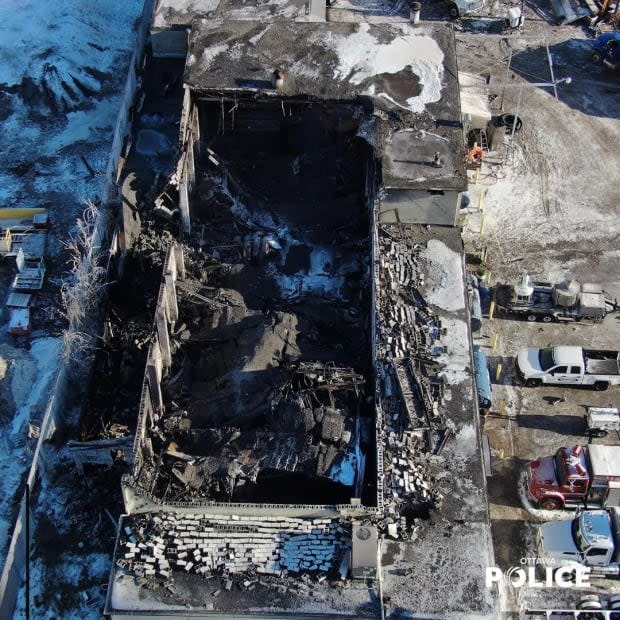
Stubborn hot spots
At 3:49 p.m., crews who have entered the mainly intact service area are ordered to pull out due to an imminent roof collapse, but advise they're "still dealing with hot spots." Twelve minutes later they retreat to get a "piercing nozzle," allowing them to punch a hole in the wall and fight the flames from outside the building.
For the next half hour, crews continue to douse hot spots as directed by their "eye in the sky" in the bucket of a tower truck.
At 4:24 p.m., dispatch announces a hazardous materials vehicle from Station 24 is on its way. Around the same time, crews begin a careful search of the building's perimeter.

Pumper 12 opens the east-facing door of the paint shop and checks the service bays. "P12 confirms everyone out of 3 bays." Minutes later, that section of the Eastway building is officially given the all-clear.
At 4:42 p.m., more than an hour after the drainage problem was identified, command asks for an "ETA or location" from the city, and is told a crew is on scene "but don't have the proper equipment." Dispatch also advises that someone from the Ministry of the Environment "will call him shortly, might send someone."
As crews are slowly relieved and replaced, a decontamination tent is set up where firefighters can doff their bunker gear to be cleansed of petroleum products.
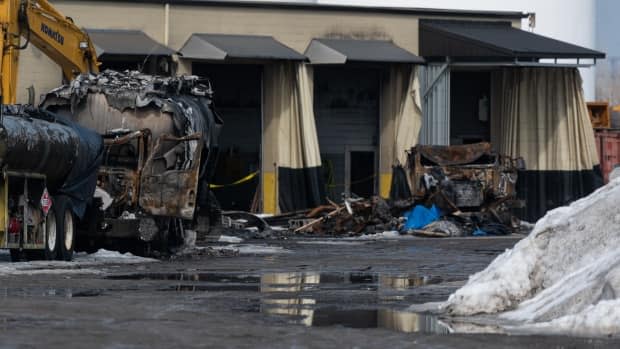
Fire declared under control
Just before 5 p.m., command asks if the fire can be declared under control, but is told crews are awaiting a "high hoe … to demolish structure." In fact, the long-reach excavator would be used to meticulously pick apart the smouldering wreckage to expose hidden hot spots, and potentially locate victims.
At 5:43 p.m. the rapid intervention team is told to stand down. Five minutes later command is notified that there are still flames in a storage room, but the fire can be declared under control.
At 6:09 p.m., apparently after consulting with Eastway staff about what kind of fuels and chemicals were in the building, a deputy chief advises: "Do not anticipate any further hazards."
At 6:15 p.m., dispatch advises that the railway tracks have been reopened.
"Crews will likely be here all night," the district chief on scene reports at 6:42 p.m.
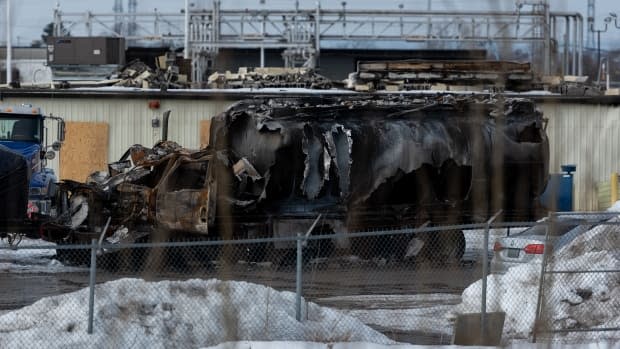
That prediction turned out to be true, as the remaining crews worked to thaw frozen hoses, shore up fuel spills and watch for stubborn flare-ups.
In fact, firefighters would be called back to the scene more than two days after explosion, as an excavator carefully picked through the wreckage, exposing a smouldering hot spot that had to be doused before investigators could begin the job of determining what caused the blast, one of the deadliest workplace incidents in Ottawa's history.
Last Monday, a spokesperson confirmed the Office of the Fire Marshal's investigation into the cause of the disaster continues.
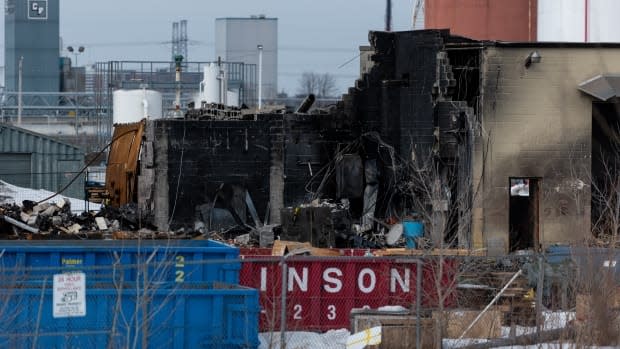

 Yahoo Movies
Yahoo Movies 
